#port authority bus terminal
Text
Foster + Partners unveils redesign for Port Authority Bus Terminal in Manhattan
The Port Authority of New York & New Jersey (PANYNJ) recently unveiled renderings of a $10 billion facelift for the Port Authority Bus Terminal—a notorious transportation hub it operates in Manhattan. The Port Authority Bus Terminal’s redesign is by Foster + Partners in-sync with the Federal Transit Administration (FTA).
The announcement signals the start of the draft environmental impact…

View On WordPress
0 notes
Text
Okay actually I think Lima’s airport is actually the worst airport I’ve ever gone through. And I’ve travelled quite a bit.
0 notes
Text
DOES ANYBODY ON THIS CLOWN FUCK WEBSITE KNOW HOW TO MAKE THE NJ TRANSIT APP WORK, BECAUSE I SURE AS FGKC COULDN'T DURING A SOLID HALF HOUR OF ATTEMPT
#sitting on the port authority bus terminal floor#in a punk jacket with three unwieldy bags and a cold coffee#so tired that articulating the issue would make me a CRYING punk-javket-and-dumb-luggage-having floor-sitter
0 notes
Text
ahem
The Crown Jewels Of Manhattan:
-99c fresh pizza on 40th and 7th
-42nd and 5th dunkies
-bryant park
-cupcake cafe (rip)
-nederlander theater
-veselkas
-the new york public library
-the morgan library
-etc on 46th street
-the port authority bus terminal
-zuckers bagels bryant park
-american girl
-chrysler building
-empire state building walgreens (rip)
-grand central station
-william h sewards statue in madison square park
dishonorable mentions:
-the flagship puma store on 5th avenue
-the 5th avenue abercrombie and fitch
-times square
-99c delicious pizza on 40th and 7th
-penn station
79 notes
·
View notes
Text
Thoughts While Watching Gilmore Girls, Season 2, Episode 21- Lorelai’s Graduation Day, Aka Lovesick Stepcousins In The Big City, Part 3
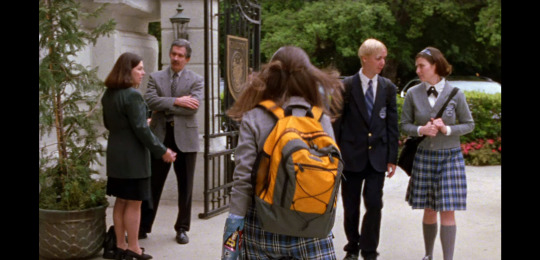
I'm cheering Rory on as she leaves school grounds, leaving these 35 year old classmates in the dust, and as she manages to pull it off under the eyes of two teachers or administrators. Yes yes yes!
Well from here on out it's going to be pure Literati appreciation with only minimal anger and rage, you know, my usual shtick. That being said, when that happens I start to sound a little disjointed, like, this episode is so pure and precious and enjoyable that I really don't have much snarky commentary on it and I can just watch it. What am I without my snark powers?

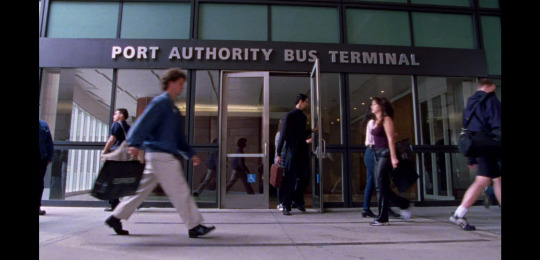
Destiny awaits.
In one of many examples of what I call "Gilmore Girls Poor"*, which is a term I coined myself for how AmyShermanPalladino views lower/middle class/urban/city life, Rory manages to end up in the Port Authority Bus Terminal in another dimension. The Alternate Dimension, 100% white, Spotlessly Clean, Nearly People-Free New York City Bus Terminal where she stared down a scary dude without being stabbed and she was offered a locker to store her book bag.
(*More examples of GGP: In season 4, Jess is 19 years old, a high school dropout, and is living in a clean, rat and roach free, enormous New York City apartment with working utiltiies and large windows that in today's housing crisis people would murder him to get, he just needed a bed frame and to pick his shit up off the floor but we are supposed to believe its a crack den; Rory and Lorelai live in a beautiful home and eat take out and restaurant food every day on nothing more than an innkeeper's slary)

This was cute. Rory the little mouse getting ignored by city folk. I love it so much.

I think AmyShermanPalladino inserted this smoking guy to make it look like Rory was in a rough part of town.
Someone finally gives our little mouse an abrupt answer on how to get to Washington Square Park where she can meet her stepcousin and her destiny.


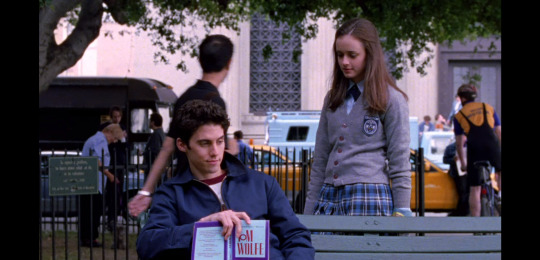
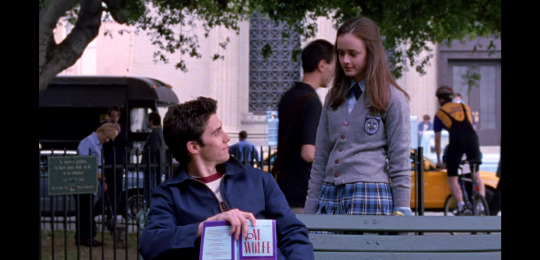
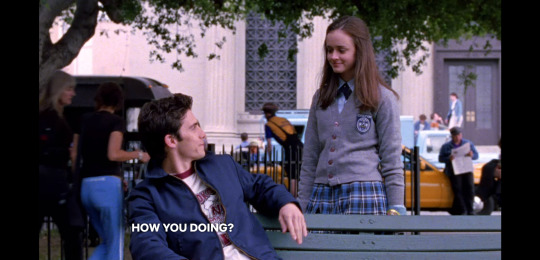
The little smirk before he turns around! And then, and then...and then...the big grin when he sees her!


I am STARVING for stepcousins!!!!!!
..And the Emmy Award for the whitest words ever spoken on teleivison goes to Alexis Bledel, as Rory Gilmore in Gilmore Girls:


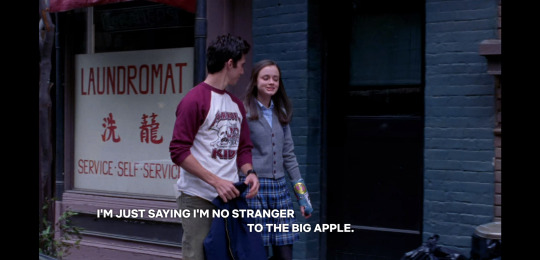

Baring his naked forearms like a saucy strumpet. Book sticking awkwardly out of his back pocket. He either finds the smallest books or has the roomiest ass pockets that he keeps pulling that off. How does he do that?

This is all so precious and pure I could die.


He is RAPT with attention listening to her silly stories. Show me where Dean or Logan ever paid this much attention to her telling one of these stories.
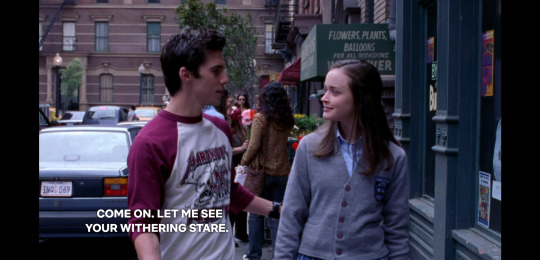

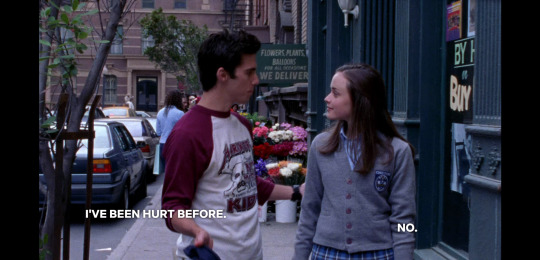
We know, Bubs. We know :(
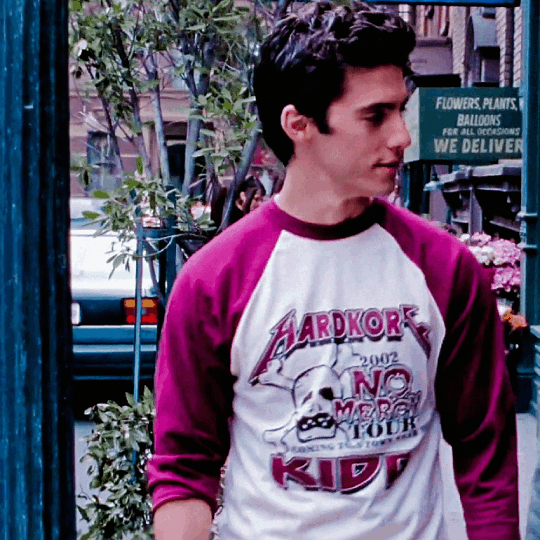

Red alert! Red alert! Our first display of physical contact!

Jess says he eats from this hot dog cart every day. Let's unpack this:
1) Holy child neglect, Batman! I mean, Liz Danes. You can't even make your kid a peanut butter and jelly sandwich once in a while? This boy is feral. These are survival hot dogs. This may be all he can afford to eat on his own.
2) How are you still as skinny as a rail?
3) How's your blood pressure?
4) Where are you getting the money?
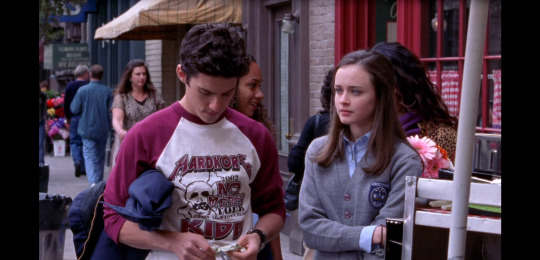
This sweet bubba unquestionably paid for Rory's lunch like a true gentleman.

I refuse to acknolwedge any sort of Behind the Scenes Hollywood mumbo jumbo like "Milo wasn't ACTUALLY eating the hot dog" or “umm, it’s a prop hot dog”. i am firmly committed to a scenario where everyone on the set for this episode was like "Milo our precious vegetarian baby boy we will get you a tofu hot dog to eat"

Ending this chapter with this adorable face.
#gilmore girls#gilmore girls season 2#lorelais graduation day#rory gilmore#jess mariano#milo ventimiglia#denise rewatches gilmore girls#literati#step cousins#my heart is bursting#hot dog#feral child#why isn’t Jess in school#he ate a hot dog in the movie Armored#I saw him deep throat the thing#tofu dog or commitment to the part that he will ingest meat for a role
80 notes
·
View notes
Text
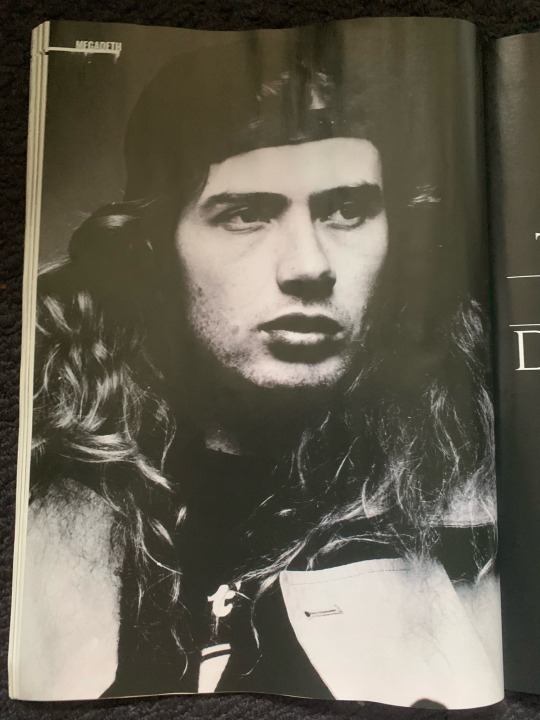
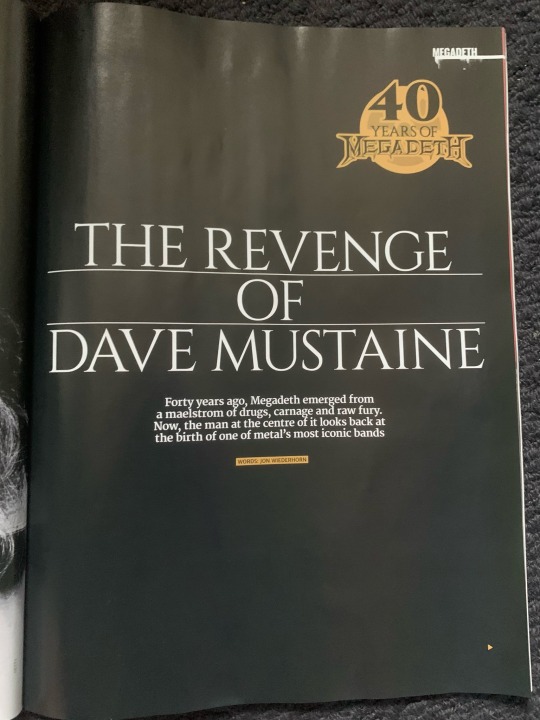
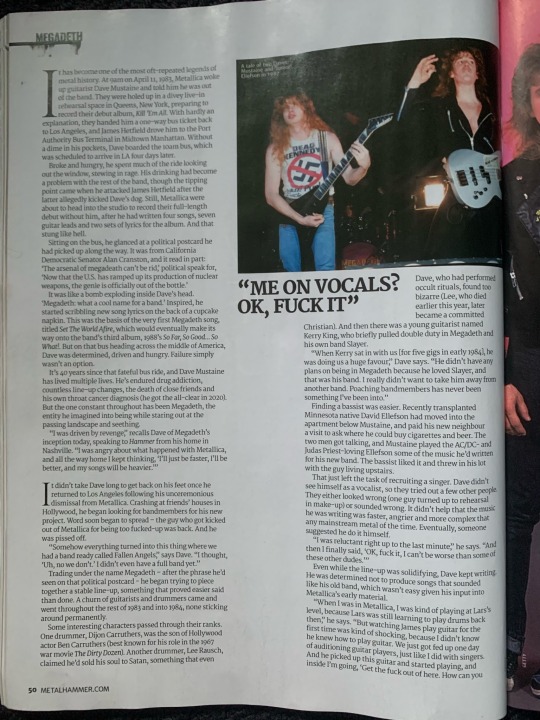
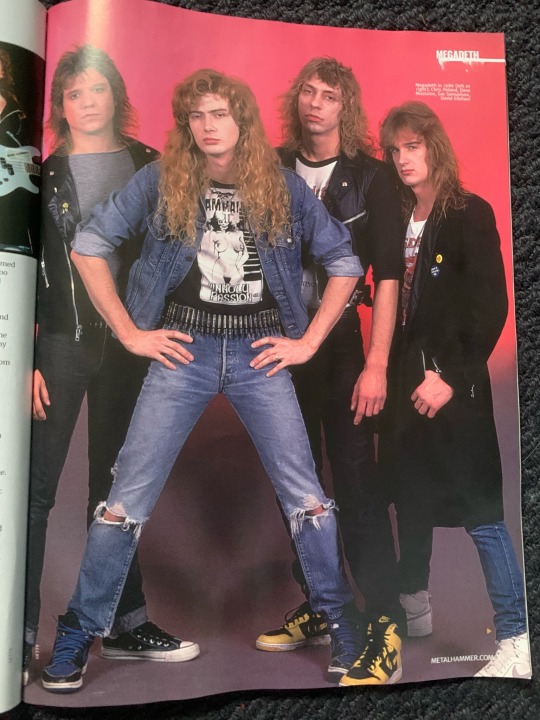
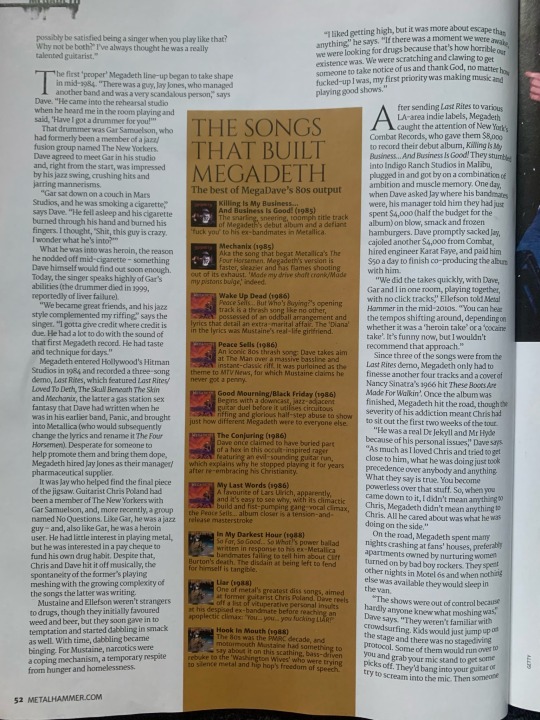
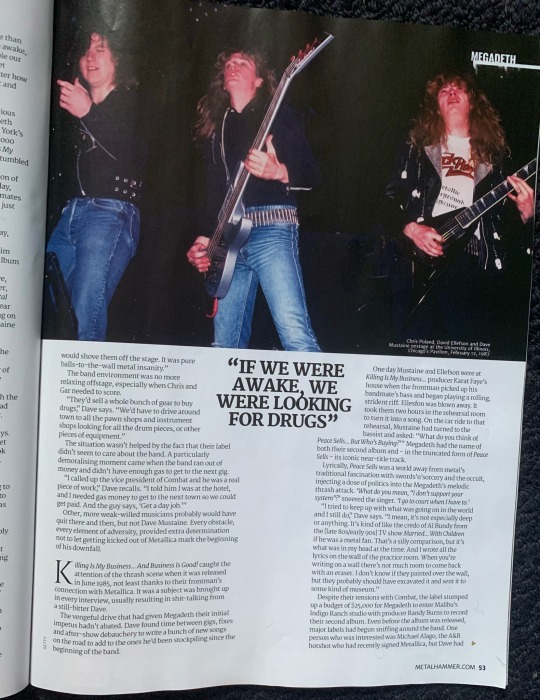

An interview with Dave Mustaine from this month’s Metal Hammer magazine. Transcript under the cut.
THE REVENGE OF DAVE MUSTAINE
Forty years ago, Megadeth emerged from a maelstrom of drugs, carnage, and raw fury. Now, the man at the centre of it looks back at the birth of one of metal’s most iconic bands.
WORDS: JON WIEDERHORN
It has become one of the most oft-repeated legends of metal history. At 9am on April 11, 1983, Metallica woke up guitarist Dave Mustaine and told him he was out of the band. They were holed up in a divey live-in rehearsal space in Queens, New York, preparing to record their debut album, Kill 'Em All. With hardly an explanation, they handed him a one way bus ticket back to Los Angeles, and James Hetfield drove him to the Port Authority Bus Terminal in Midtown Manhattan. Without a dime in his pockets, Dave boarded the 10am bus, which was scheduled to arrive in LA four days later.
Broke and hungry, he spent much of the ride looking out the window, stewing in rage. His drinking had become a problem with the rest of the band, though the tipping point came when he attacked James Hetfield after the latter allegedly kicked Dave's dog. Still, Metallica were about to head into the studio to record their full-length debut without him, after he had written four songs, seven guitar leads and two sets of lyrics for the album. And that stung like hell.
Sitting on the bus, he glanced at a political postcard he had picked up along the way. It was from California Democratic Senator Alan Cranston, and it read in part: ‘The arsenal of megadeath can't be rid,’ political speak for, ‘now that the U.S. has ramped up its production of nuclear weapons, the genie is officially out of the bottle.'
It was like a bomb exploding inside Dave's head. ‘Megadeth: what a cool name for a band.’ Inspired, he started scribbling new song lyrics on the back of a cupcake napkin. This was the basis of the very first Megadeth song, titled Set The World Afire, which would eventually make its way onto the band's third album, 1988's So Far, So Good...So What!. But on that bus heading across the middle of America, Dave was determined, driven and hungry. Failure simply wasn't an option.
It's 40 years since that fateful bus ride, and Dave Mustaine has lived multiple lives. He's endured drug addiction, countless line-up changes, the death of close friends and his own throat cancer diagnosis (he got the all-clear in 2020). But the one constant throughout has been Megadeth, the entity he imagined into being while staring out at the passing landscape and seething.
"I was driven by revenge" recalls Dave of Megadeth's inception today, speaking to Hammer from his home in Nashville. "I was angry about what happened with Metallica, and all the way home I kept thinking, 'I'll just be faster, I'll be better, and my songs will be heavier."
It didn't take Dave long to get back on his feet once he returned to Los Angeles following his unceremonious dismissal from Metallica. Crashing at friends' houses in Hollywood, he began looking for bandmembers for his new project. Word soon began to spread - the guy who got kicked out of Metallica for being too fucked-up was back. And he was pissed off.
"Somehow everything turned into this thing where we had a band ready called Fallen Angels" says Dave. "I thought, "Uh, no we don't.!' I didn't even have a full band yet."
Trading under the name Megadeth - after the phrase he'd seen on that political postcard - he began trying to piece together a stable line-up, something that proved easier said than done. A churn of guitarists and drummers came and went throughout the rest of 1983 and into 1984, none sticking around permanently.
Some interesting characters passed through their ranks. One drummer, Dijon Carruthers, was the son of Hollywood actor Ben Carruthers (best known for his role in the 1967 war movie The Dirty Dozen). Another drummer, Lee Rausch, claimed he'd sold his soul to Satan, something that even Dave, who had performed occult rituals, found too bizarre (Lee, who died earlier this year, later became a committed Christian). And then there was a young guitarist named Kerry King, who briefly pulled double duty in Megadeth and his own band Slayer.
"When Kerry sat in with us [for five gigs in early 1984), he was doing us a huge favour" Dave says. "He didn't have any plans on being in Megadeth because he loved Slayer, and that was his band. I really didn't want to take him away from another band. Poaching bandmembers has never been something I've been into."
Finding a bassist was easier. Recently transplanted Minnesota native David Ellefson had moved into the apartment below Mustaine, and paid his new neighbour a visit to ask where he could buy cigarettes and beer. The two men got talking, and Mustaine plaved the AC/DC- and Judas Priest-loving Ellefson some of the music he'd written for his new band. The bassist liked it and threw in his lot with the guy living upstairs.
That just left the task of recruiting a singer. Dave didn't see himself as a vocalist, so they tried out a few other people. They either looked wrong (one guy turned up to rehearsal in make-up) or sounded wrong. It didn't help that the music he was writing was faster, angrier and more complex that any mainstream metal of the time. Eventually, someone suggested he do it himself.
"I was reluctant right up to the last minute," he says. "And then I finally said, OK, fuck it, I can't be worse than some of these other dudes."
Even while the line-up was solidifying, Dave kept writing. He was determined not to produce songs that sounded like his old band, which wasn't easy given his input into Metallica's early material.
"When I was in Metallica, I was kind of playing at Lars's level, because Lars was still learning to play drums back then," he says. "But watching James play guitar for the first time was kind of shocking, because I didn't know he knew how to play guitar. We just got fed up one day of auditioning guitar players, just like I did with singers. And he picked up this guitar and started playing, and inside I'm going, 'Get the fuck out of here. How can you possibly be satisfied being a singer when you play like that? Why not be both?' I've always thought he was a really talented guitarist."
The first 'proper' Megadeth line-up began to take shape in mid-1984. "There was a guy, Jay Jones, who managed another band and was a very scandalous person," says Dave. "He came into the rehearsal studio when he heard me in the room playing and said, 'Have I got a drummer for you!"" That drummer was Gar Samuelson, who had formerly been a member of a jazz/ fusion group named The New Yorkers.
Dave agreed to meet Gar in his studio and, right from the start, was impressed by his jazz swing, crushing hits and jarring mannerisms.
"Gar sat down on a couch in Mars Studios, and he was smoking a cigarette," says Dave. "He fell asleep and his cigarette burned through his hand and burned his fingers. I thought, 'Shit, this guy is crazy. wonder what he's into?”
What he was into was heroin, the reason he nodded off mid-cigarette - something Dave himself would find out soon enough. Today, the singer speaks highly of Gar's abilities (the drummer died in 1999, reportedly of liver failure).
"We became great friends, and his jazz style complemented my riffing," says the singer. "I gotta give credit where credit is due. He had a lot to do with the sound of that first Megadeth record. He had taste and technique for days."
Megadeth entered Hollywood's Hitman Studios in 1984 and recorded a three-song demo, Last Rites, which featured Last Rites/ Loved To Deth, The Skull Beneath The Skin and Mechanix, the latter a gas station sex fantasy that Dave had written when he was in his earlier band, Panic, and brought into Metallica (who would subsequently change the lyrics and rename it The Four Horsemen). Desperate for someone to help promote them and bring them dope, Megadeth hired Jay Jones as their manager/ pharmaceutical supplier.
It was Jay who helped find the final piece of the jigsaw. Guitarist Chris Poland had been a member of The New Yorkers with Gar Samuelson, and, more recently, a group named No Questions. Like Gar, he was a jazz guy - and, also like Gar, he was a heroin user. He had little interest in playing metal, but he was interested in a pay cheque to fund his own drug habit. Despite that, Chris and Dave hit it off musically, the spontaneity of the former's playing meshing with the growing complexity of the songs the latter was writing.
Mustaine and Ellefson weren't strangers to drugs, though they initially favoured weed and beer, but they soon gave in to temptation and started dabbling in smack as well. With time, dabbling became binging. For Mustaine, narcotics were a coping mechanism, a temporary respite from hunger and homelessness.
“I liked getting high, but it was more about escape than anything." he says. "If there was a moment we were awake, we were looking for drugs because that's how horrible our existence was. We were scratching and clawing to get someone to take notice of us and thank God, no matter how fucked-up I was, my first priority was making music and playing good shows."
After sending Last Rites to various L.A.-area indie labels, Megadeth caught the attention of New York’s Combat Records, who gave them $8,000 to record their debut album, Killing Is My Business... And Business Is Good! They stumbled into Indigo Ranch Studios in Malibu, plugged in and got by on a combination of ambition and muscle memory. One day, when Dave asked Jay where his bandmates were, his manager told him they had just spent $4,000 (half the budget for the album) on blow, smack and frozen hamburgers. Dave promptly sacked Jay, cajoled another $4,000 from Combat, hired engineer Karat Faye, and paid him $50 a day to finish co-producing the album with him.
“We did the takes quickly, with Dave, Gar and I in one room, playing together, with no click tracks," Ellefson told Metal Hammer in the mid-2010s. "You can hear the tempos shifting around, depending on whether it was a 'heroin take' or a 'cocaine take'. It's funny now, but I wouldn't recommend that approach."
Since three of the songs were from the Last Rites demo, Megadeth only had to finesse another four tracks and a cover of Nancy Sinatra's 1966 hit These Boots Are Made For Walkin'. Once the album was finished, Megadeth hit the road, though the severity of his addiction meant Chris had to sit out the first two weeks of the tour.
"He was a real Dr Jekyll and Mr Hyde because of his personal issues," Dave says. "As much as I loved Chris and tried to get close to him, what he was doing just took precedence over anybody and anything. What they say is true. You become powerless over that stuff. So, when you came down to it, I didn't mean anything to Chris, Megadeth didn't mean anything to Chris. All he cared about was what he was doing on the side."
On the road, Megadeth spent many nights crashing at fans' houses, preferably apartments owned by nurturing women turned on by bad boy rockers. They spent other nights in Motel 6s and when nothing else was available they would sleep in the van.
"The shows were out of control because hardly anyone knew what moshing was," Dave says. "They weren't familiar with crowdsurfing. Kids would just jump up on the stage and there was no stagediving protocol. Some of them would run over to you and grab your mic stand to get some picks off. They'd bang into your guitar or try to scream into the mic. Then someone would shove them off the stage. It was pure balls-to-the-wall metal insanity."
The band environment was no more relaxing offstage, especially when Chris and Gar needed to score.
"They'd sell a whole bunch of gear to buy drugs" Dave says. "We'd have to drive around town to all the pawn shops and instrument shops looking for all the drum pieces, or other pieces of equipment."
The situation wasn't helped by the fact that their label didn't seem to care about the band. A particularly demoralising moment came when the band ran out of money and didn't have enough gas to get to the next gig.
"I called up the vice president of Combat and he was a real piece of work" Dave recalls. "I told him I was at the hotel, and I needed gas money to get to the next town so we could get paid. And the guy says, 'Get a day job."
Other, more weak-willed musicians probably would have quit there and then, but not Dave Mustaine. Every obstacle, every element of adversity, provided extra determination not to let getting kicked out of Metallica mark the beginning of his downfall.
Killing Is My Business... And Business Is Good! caught the attention of the thrash scene when it was released in June 1985, not least thanks to their frontman's connection with Metallica. It was a subject was brought up in every interview, usually resulting in shit talking from a still-bitter Dave.
The vengeful drive that had given Megadeth their initial impetus hadn't abated. Dave found time between gigs, fixes and after-show debauchery to write a bunch of new songs on the road to add to the ones he'd been stockpiling since the beginning of the band.
One day Mustaine and Ellefson were at Killing Is My Business... producer Karat Faye's house when the frontman picked up his bandmate's bass and began playing a rolling, strident riff. Ellesfon was blown away. It took them two hours in the rehearsal room to turn it into a song. On the car ride to that rehearsal, Mustaine had turned to the bassist and asked: "What do you think of Peace Sells... But Who's Buying?” Megadeth had the name of both their second album and - in the truncated form of Peace Sells - its iconic near-title track.
Lyrically, Peace Sells was a world away from metal's traditional fascination with swords'n'sorcery and the occult, injecting a dose of politics into the Megadeth's melodic thrash attack. What do you mean, "I don't support your system"?" sneered the singer. 'I go to court when I have to.'
"I tried to keep up with what was going on in the world and I still do,” Dave says. "I mean, it's not especially deep or anything. It's kind of like the credo of Al Bundy from the (late 80s/early 90s] TV show Married... With Children if he was a metal fan. That's a silly comparison, but it's what was in my head at the time. And I wrote all the lyrics on the wall of the practice room. When you're writing on a wall there's not much room to come back with an eraser. I don't know if they painted over the wall, but they probably should have excavated it and sent it to some kind of museum.
Despite their tensions with Combat, the label stumped up a budget of $25,000 for Megadeth to enter Malibu's Indigo Ranch studio with producer Randy Burns to record their second album. Even before the album was released, major labels had begun sniffing around the band. One person who was interested was Michael Alago, the A&R hotshot who had recently signed Metallica, but Dave had no interest in being on the same label as his former bandmates-turned-antagonists.
"I didn't want to play second fiddle to them." he says.
In the end, they signed with Capitol, who opted to buy Megadeth out of their contract with Combat and bring in producer Paul Lani to remix it and give it a slicker sound. Along with the deal came a noticeable improvement in the band's financial situation - as Capitol's shiny new thrash metal band, Megadeth received more tour support and bigger royalty cheques than they'd ever got on Combat. But much of the money they were now making went into their expensive pharmaceutical habits. Even though he was deep in his own addiction, Dave knew that providing some sense of leadership was important, now more than ever before.
"I quickly realised that when stuff goes wrong - and it does go wrong - that if you're the leader, you need to take responsibility for shit even when it's not your fault,” he says. “You need to step up and make it right. I look at stuff and say, 'I've got to do whatever I can to make this right. We've come too far for everything to go sideways."
To Dave Mustaine, righting the ship has also meant knowing when it's time to make changes. In June 1987, Megadeth wrapped up the tour in support of Peace Sells... But Who's Buying? with two shows in Honolulu, Hawaii. When the band got back to LA, Gar Samuelson and Chris Poland were jonesing for a fix. According to the frontman, they ended up selling band equipment again to buy more drugs. It was the final straw.
"I was totally fed up," Mustaine says. "I guess it was just one too many times driving around Los Angeles trying to find everybody's band gear. I told Ellefson, 'Well, that's it. I'm breaking up the band and I'm getting rid of those guys. If you want to stay with me that's fine."
David Ellefson did stay, though Chris and Gar were history. They'd eventually be replaced by guitarist Jeff Young and drummer Chuck Behler, whose one-album tenure - they appeared on 1988's chaotic So Far, So Good... So What! - proved to be no less volatile.
Forty years after Dave Mustaine formed Megadeth in the wake of his firing from Metallica, much has changed about both the band and their leader. Today, he's the sole remaining original member and the only one who has played on every album (after leaving and rejoining the band in the 2000s, David Ellison was ousted for a second and seemingly final time in 2021 following an online sex scandal.) The singer himself cleaned up long ago, embracing his Christian faith in the process.
But at the same time, the single-mindedness and stubborn streak that saw him pick himself up post-Metallica and build an entirely new band remains intact. Lesser musicians would have folded a long time ago, but not Dave Mustaine. And it all dates back to those earl vears when he had so much to prove and nothing to lose.
"We went through everything, man, from what happened on the road, to homelessness, to starvation," he says. "The panhandling, the sleeping on people's floors. The destitution the desperation and poverty. We survived it all."
MEGADEATH’S LATEST ALBUM THE SICK THE DYING… AND THE DEAD! IS OUT NOW VIA UMC
Sidebar:
THE SONGS THAT BUILT MEGADETH
The best of Megadeth’s 80s output
Killing Is My Business… And Business Is Good! (1985)
The snarling, sneering, 100mph title track of Megadeth’s debut album and a defiant ‘fuck you' to his ex-bandmates in Metallica.
Mechanix (1985)
Aka the song that begat Metallica's The Four Horsemen. Megadeth’s version is faster, sleazier, and had flames shooting out of its exhaust. 'Made my drive shaft crank/Made my pistons bulge,’ indeed.
Wake Up Dead (1986)
Peace Sells... But Who's Buying?'s opening track is a thrash song like no other, possessed of an oddball arrangement and lyrics that detail an extra-marital affair. The 'Diana' in the lyrics was Mustaine's real-life girlfriend.
Peace Sells (1986)
An iconic 80s thrash song: Dave takes aim at The Man over a massive bassline and ver instant-classic riff. It was purloined as the theme to MTV News, for which Mustaine claims he never got a penny.
Good Mourning/Black Friday (1986)
Begins with a downcast, jazz-adiacent guitar duel before it utilises circuitous riffing and glorious half-step abuse to show just how different Megadeth were to everyone else.
The Conjuring (1986)
Dave once claimed to have buried part of a hex in this occult-inspired rager ako featuring an evil-sounding guitar run, which explains why he stopped playing it for years after re-embracing his Christianity.
My Last Words (1986)
A Favourite of Lars Ulrich, apparently, and it's easy to see why, with its climactic build and fist-pumping gang-vocal climax, the Peace Sells... album closer is a tension-and-release masterstroke
In My Darkest Hour (1988)
So Far, So Good... So What!'s power ballad written in response to his ex-Metallica bandmates failing to tell him about Cliff Burton's death. The disdain at being left to fend for himself is tangible.
Liar (1988)
One of metal's greatest diss songs, aimed at former guitarist Chris Poland. Dave reels off a list of vituperative personal insults at his despised ex-bandmate before reaching an apoplectic climax: 'You... you... you fucking LIAR!'
Hook In Mouth (1988)
The 80s was the PMRC decade, and motormouth Mustaine had something to say about it on this scathing, bass-driven rebuke to the ‘Washington Wives' who were trying to silence metal and hip hop's freedom of speech.
"METALLICA WOULD COME TO OUR SHOWS!"
Ex-Megadeth bassist David Junior' Ellefson looks back on his early days in the band
WHERE DID YOU FIRST MEET DAVE MUSTAINE?
"I'd moved to Hollywood with my friends and Dave had an apartment directly above. We went and knocked on his door to buy cigarettes and he went, 'Down the street' and slammed the door in our faces. We went back later and asked him where to buy beer and he looked us up and down and said, 'All right, now you're speaking my language."
HOW MUCH INPUT DID YOU HAVE IN THE SONGWRITINGEARLY ON?
"Dave wrote the songs that cast the die of whatever Megadeth was going to be, but at the same time those songs were put together in the band room, and when you're in a room together there's a lot of collaboration. There are musical moments that happen that would never have happened with one guy putting, the songs together on his own.”
HOW WAS IT PLAYING WITH SLAYER'S KERRY KING, WHO WAS BRIEFLY IN THE BAND?
"Going to San Francisco with us opened his eyes to what thrash metal was, seeing bands like Exodus. Kerry went back to LA and Slayer took the make-up off and became more the band that we knew them to be."
HOW CHAOTIC WERE THOSE EARLY DAYS?
"Everything in Megadeth was chaotic because we were poor and we were on drugs. Some bands 'party' and to me that's beer and a little weed, hanging out. When you get into heavier drugs like cocaine and especially heroin, that’s not partying. You’re going down a very dark, secluded road.”
YOU AND DAVE WERE HOMELESS FOR A WHILE, RIGHT?
"Oh yeah, we were living in the rehearsal room, living in my van, finding people to take us in to crash at their house. Me and Dave would hock our guitars on any given week. We had these little phone sales jobs so when we got some money together we'd go get our guitars out of hock so we could go to rehearsal that week."
WAS THERE A RIVALRY BETWEEN BANDS IN THE SCENE?
"I'd say there a friendly rivalry. Dave was obviously furious about being let go from Metallica but Lars and the guys would come to some of our shows. For me, the rivalry was never Metallica. i'd listen to them and go, 'Fuck, they're hitting every mark. I know it was hard for Dave because how could it not be to look to the left and see Metallica going straight to the top?'
HOW DO YOU LOOK BACK AT YOUR TIME IN MEGADETH?
"No regrets and 100% pride. I will always be a lifelong champion of that band and legacy because It never would have happened without me - I financed the Killing Is My Business tour on my dad's credit card! I'm very proud of the years I was there. It's a cherished moment in time."
TO HELL AND BACK, THE NEW ALBUM FROM DAVID'S NEW BAND, DIETH, IS OUT NOW VIA NAPALM
69 notes
·
View notes
Text
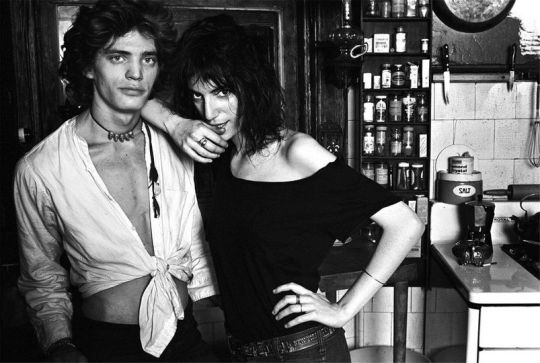
Patti Smith arrived in New York on July 3, 1967, via the decidedly un-scenic Port Authority Bus Terminal (625 8th Ave.), where she immediately transferred to the subway and headed for Brooklyn. She hoped to connect with a friend who was enrolled at the nearby Pratt Institute, an Engineering and Arts college in Clinton Hill. Unfortunately, it was summer break and her friend had moved to a new apartment. One of the current residents knew where her friend could be found, though, and offered to direct her there. This would be her first fleeting encounter with Robert Mapplethorpe, a young Pratt art student, and the man who would ultimately become her closest companion for the next few years. Alas, her friend was not at the said address, so Patti would sleep rough for the next several days, on porches, and in Central Park close to the statue of Alice in Wonderland.
Like many young newcomers, she would wander the streets of Greenwich Village and spend hours observing the people in Washington Square Park, an active gathering place for artists, folkies, activists, and people of every stripe imaginable. She explored St. Marks Place and the East Village, then a fairly ragged but colorful neighborhood of immigrants, hippies, artists, and the poor, always dragging her plaid suitcase along with her. One day she and a street friend found a little money and treated themselves to a hot meal at the Waverly Diner (385 6th Ave.), but otherwise she ate day-old bread and handouts. The rest of the time she was desperately looking for work, and after a disastrous single shift waiting tables at a Times Square restaurant, she found work at the midtown flagship location of Brentano’s (586 5th Ave.), a venerable bookstore near Rockefeller Center. She still had no place to stay, though, and often surreptitiously slept in the store overnight, only to emerge from the bathroom in the morning as the others readied the store. One day she ran into Mapplethorpe again in the bookstore. He, coincidentally, worked at the downtown branch of Brentano’s (20 University Pl.) in the Village. Not long afterwards, in the midst of an uncomfortable date with an older bookstore patron, Patti spotted Mapplethorpe in Tompkins Square Park, where he happily rescued her by posing as her boyfriend. The two shared an egg cream at Gem Spa (131 2nd Ave.) while commiserating. The pair would become inseparable. He brought her to stay at his place, an attic room in the home of some friends on Waverly Avenue in Brooklyn. After several weeks, the two had enough money saved for their own place nearby at 160 Hall St. on the second floor for $80 per month. This would become their headquarters for well over a year.
By winter, both Patti and Robert had lost their jobs at Brentano’s but found seasonal employment at FAO Schwarz (745 5th Ave.), the gigantic toy shop. Robert decorated windows, but Patti was stuck at the cash register. Afterward, she worked briefly at Argosy Books (116 E. 59th St.) before settling at Scribner’s Book Store (597 5th Ave.). Scribner’s would be her steady job for the next couple of years. Robert, meanwhile, went through a succession of jobs, one of which was as an usher at the Fillmore East (105 2nd Ave.), where he was able to get Patti in to see the Doors. Jim Morrison was to have a lasting influence on her...
-- Excerpt from the Rock and Roll Explorer Guide to New York City (Globe Pequot Press, June 2018) by Mike Katz and Crispin Kott, with a foreword by Legs McNeil. Also available by the same authors: Rock and Roll Explorer Guide to San Francisco and the Bay Area (Globe Pequot Press, May 2021), with a foreword by Joel Gion of the Brian Jonestown Massacre. Get ‘em both wherever books are sold at maximum volume.
Patti Smith & Robert Mapplethorpe by Norman Seeff,
77 notes
·
View notes
Text
#MTAMusic is full of surprises for subway riders! #MTAMusic performer Augie Bello was playing “You’re Beautiful” at 42 St-Port Authority Bus Terminal station earlier this week when James Blunt happened by and joined him in song.
Look out for #MTAMusic live performances on your daily commute, and discover more about the Music Under New York program on our website!
23 notes
·
View notes
Text


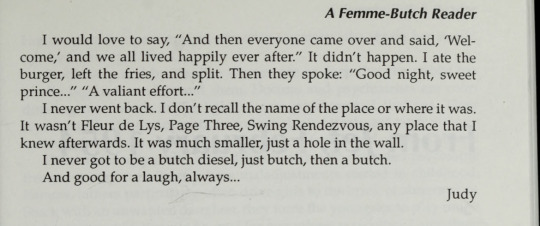
" March 20, 1991
Dear Joan:
The spirit moves:
1950. For those who do not remember 1950, let me set the stage: television existed and I had seen it on display in a store but didn't know anyone who owned one. Sex existed, but no one talked about it, except in euphemisms: she's "that way" or "you know" meant a woman was pregnant; she "does things" meant she had sex; she "does things to other girls" meant she was gay. The word homosexual was used only in newspapers in "were-arrested" stories, all of which referred to men.
I was never called a lesbian. We were "queers" or "perverts" or the worst group-you-wouldn't-want-to-be-caught-dead-with: "dykes." And we were also arrested, but it never made the papers- I guess because it was so ordinary, not newsworthy.
The word butch was used to describe mannish behavior. She walks butch, she thinks butch, she looks butch, but I do not recall she is a butch. A tough-acting woman in man's clothes was called a butch diesel. I desperately wanted to be a butch diesel.
This would be a great accomplishment for a sixteen-year-old suburban kid, cruising weekends in the village. I had been in "the life" on the streets- it wasn't enough. I wanted to go into the butch diesels bars, to be accepted as one of them. They were tough, cocky, sure of themselves. They intimidated by their very existence. And they never ended up in a cage at the Country Club (the Women's House of Detention, located in the heart of the Village), never fell victim to street sweeps. They were cool!
How to start...
For openers, I took the bus to New York wearing a skirt and blouse and carrying a purse containing a hip flask of stale beer, a nice fitting man's shirt, and a pair of men's slacks, liberated from my half brother. The bus station- then about half a block east of the south end of Times Square, before the Port Authority Terminal was built- was a stinking hole, but it did have rental lockers and an alley nearby.
I changed into the boy clothes in the alley, plastered my pageboy girl hair back into a decent DA (duck's ass, dear children: it came to a pointed line down the back of the head- very popular with greasers), and jammed the flask into one back pocket. No wallet; loose money went into the right front pocket. Then I put the girl clothes and purse in the locker and viola- instant freedom to walk the streets literally unmolested.
Understand: boys and men could walk the streets- just walk, not solicit or what have you, just plain be on the streets at night- and no one would challenge them. But a girl or woman alone had to be a hooker or lost and in need of protection. This was handy if one was working the streets but of no use at all if one wanted to be accepted as a butch diesel and not just a street kid.
I had already found the bar to be entered. I had been shown it by a street friend who was highly amused that I did not at first believe that the "men" entering were really women. You couldn't tell unless you heard them talk, and even then sometimes I wasn't sure. I had finally accepted the truth and had watched them go in, alone or with snazzily dressed women. But I had never dared enter; it was out of my league. Well, no longer- I was ready!
So in I went. All conversations stopped, all eyes upon me. This was standard whenever any stranger entered a gay bar in those days. The darkness of the bars allowed those inside to see the person entering before his or her eyes adjusted to see them. If you passed muster, if the patrons concluded you were not a vice cop or a known troublemaker, conversation would start again.
Which is not to say you would be accepted. No, you would be ignored, watched, tentatively approached if... But first, the pin-drop silence. Oh Lord, the agony of waiting to see if they would accept me! And then, finally, the silence was broken: "Oh my god, Millie," someone said, "It's Prince Valiant!"
And everyone roared with laughter, and I knew, I knew... My hand reached up to find that my baby-fine hair had shed the beer glop and had drifted down and forward to hang limply about my ears. I reached for the flask then realized it was too late. What would I do with it? Pour it on my head? I just held it on the table, too numb to move, too embarrassed to speak or even lift my head.
The eternity ended when the waitress asked if I wanted something to eat. Every gay bar I recall in those days was nominally a cafe, so they had to serve food (hamburgers, fries) and especially if you were not known, you had to order whatever overpriced inedible food they offered. Then you would be asked if you wanted anything to drink with it. I knew about that game from other bars, but still speechless, I only nodded.
I would love to say, "And then everyone came over and said, 'Welcome.,' and we all lived happily ever after." It didn't happen. I ate the burger, left the fries, and split. Then they spoke: "Good night, sweet prince..." "A valiant effort..."
I never went back. I don't recall the name of the place or where it was. It wasn't Fleur de Lys, Page Three, Swing Rendezvous, any place that I knew afterwards. It was much smaller, just a hole in the wall.
I never got to be a butch diesel, just butch, then a butch.
And good for a laugh, always...
Judy"
"A Letter" by Judy Lederer, The Persistent Desire: A Butch Femme Reader, edited by Joan Nestle (1992)
#the persistent desire#the persistent desire: a butch femme reader#joan nestle#lesbian#lesbianism#butch#butch history#butch lesbian#lesbian lit#lesbian history#lgbt#lgbtq+ lit#gay lit#gay history
26 notes
·
View notes
Photo

Buses and passengers outside the All American Bus Depot, 1940s. The Port Authority’s terminal didn’t open until December of 1950.
Photo: Classic Stock/Alamy/Time Out NY
#New York#NYC#vintage New York#1940s#bus terminal#bus depot#vintage bus#autochrome#mass transportation
282 notes
·
View notes
Text
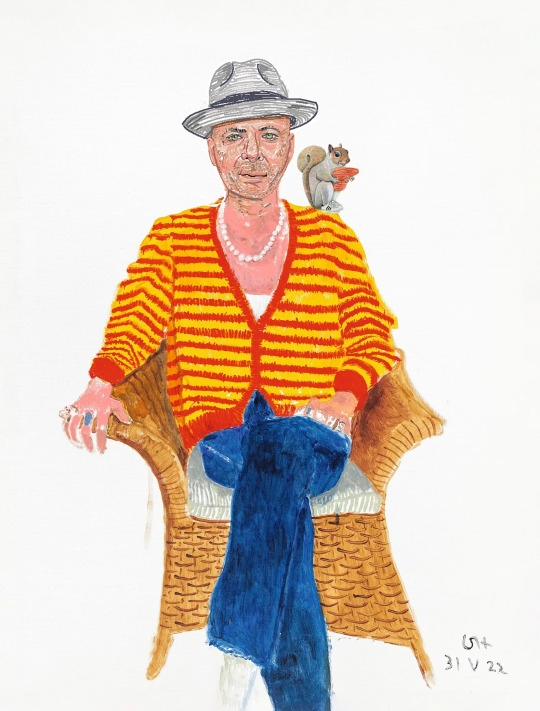
I recently posed for the legendary painter, David Hockney. He told me that I'm very good at sitting still. The painting will now hang in the men’s room at the Port Authority Bus Terminal in New York City.
7 notes
·
View notes
Text
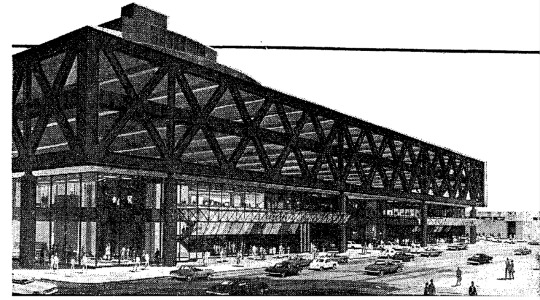
THE FRIDAY PIC is a 1980s rendering of New York's Port Authority Bus Terminal, in the news again as plans to replace it are moving forward, to much celebration.
A few years ago, I published a love letter to the PABT: https://brooklynrail.org/2021/02/special-report/Praising-the-Port-Authority-Terminal.
Rereading that piece today, in the face of all that celebration of its coming demise, I feel I should apologize for what I wrote: It was too half-hearted in its praise of the building.
I'm more than ever convinced that it is one of the truly great structures in New York, and by a long shot one of the most original. It's a fabulous example of functionalist Brutalism, descended straight from such functional treasures as the Roman aqueduct in Segovia.
We mourn the loss of the old Penn Station, even though plenty of experts once thought it was the height of Beaux Arts kitsch. Judging from the drawings I've seen for the PABT's banal replacement, we'll mourn the loss of its Brutalist ancestor just as much.
5 notes
·
View notes
Text

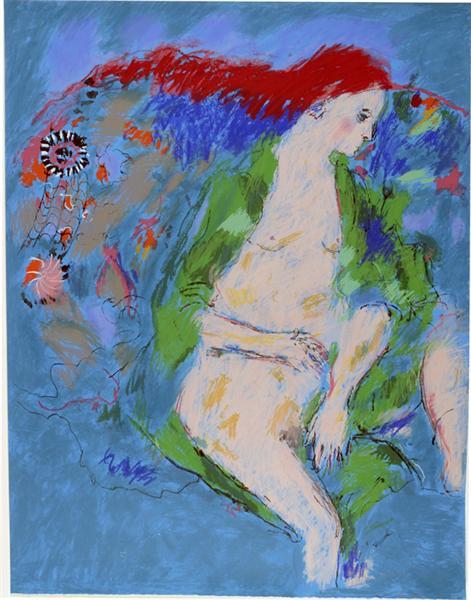
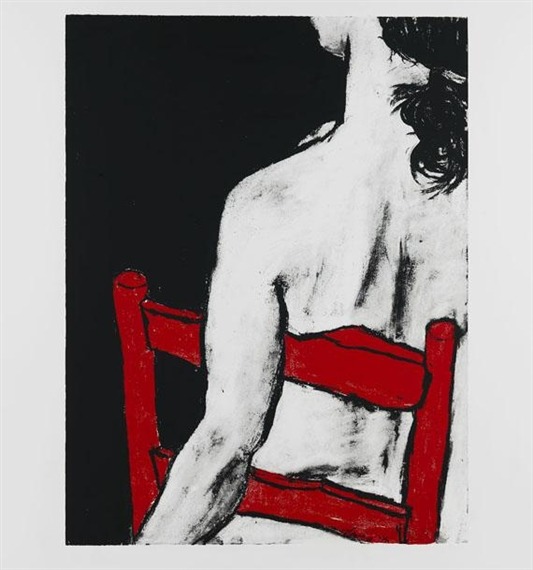

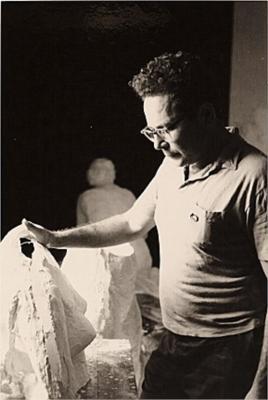

George Segal (1924 - 2000) was born in New York City. His parents ran a butcher shop on 174th Street in the Bronx. By the time Segal was attending Stuyvesant High School in Lower Manhattan, his family had moved to New Jersey to run a chicken farm. Segal, who stayed on with relatives in New York to finish high school, was later admitted to the prestigious Cooper Union Art School. When his older brother Morris was drafted in 1940, George moved from New York to New Jersey to help support his family on the farm. Segal went on to spend the rest of his productive life in the bedroom community of New Brunswick, New Jersey.
For decades throughout his art career, Segal traveled by bus into Manhattan. Entering the city through the Port Authority bus terminal on Fortieth Street and Eighth Avenue, Segal explored the hidden nooks of the city with his camera. Segal traveled to neighborhoods such as the Bowery and the East Village to experience the city and interact with its various inhabitants. As a native New Yorker, Segal was one of them. But as an artist, Segal’s role shifted to that of observer. He then translated observation and insight into sculptural form, rendering vignettes of daily urban life into aggregates of ghostly—but realistic—plaster and bronze figures. Widely regarded as one of the 20th century’s most influential sculptors, George Segal died in 2000.
4 notes
·
View notes
Text
yeah i have rizz (i know how to navigate the port authority bus terminal)
178 notes
·
View notes
Text

Masbia Relief Team members distribute aid to asylum-seekers arriving at the Port Authority Bus Terminal in Manhattan, New York, on Aug. 19, 2022. Photo courtesy of Masbia
6 notes
·
View notes
Photo


Stevie Bates vanished in Queens, New York on April 28th, 2012. The then-19-year-old disappeared after taking a cross-country road trip. Stevie returned to New York via bus and was captured on surveillance footage at the Port Authority Bus Terminal. Shortly after exiting the bus, Stevie called her mother and said she was going to visit her boyfriend at a property where he had been squatting. She was never seen or heard from again.
According to Stevie's mother, the NYPD was not very helpful when she first reported Stevie missing. The police reportedly told Stevie's mother that she was an adult and maybe did not want to be found. However, Stevie's mother knew it was uncharacteristic for Stevie to fall out-of-touch and she was immediately worried for her daughter's safety.
Years passed without any updates in Stevie's case. Then, in 2020, human remains were found at a construction site on Cypress Avenue in Glendale, Queens. A construction worker noticed that there was a rolled-up blanket about five feet down a bank. When the blanket was removed by an excavator, the construction workers noticed that there were bones inside. It took months, but in March 2021, the remains were identified as that of Stevie Bates. Her death was classified as a homicide.
Stevie's mother said that the building where Stevie was found is the same building where she said she was going to meet her boyfriend on the day she vanished. Reports state that the boyfriend was interviewed by police, but he denied any involvement in Stevie's disappearance. At this time, he has not been named as a suspect or even a person-of-interest.
Stevie's murder remains unsolved. If you have any information that could help convict her killer(s), please call 1-800-577-TIPS.
#stevie bates#murder case#unsolved#unsolved murder#unsolved mystery#new york#2012#true crime#true crime research#tcoriginal#justice for stevie
49 notes
·
View notes